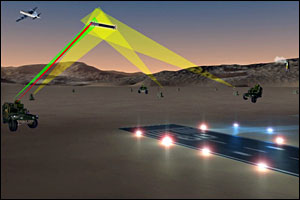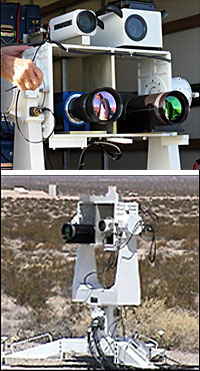
GD Pitches Ground Laser
General Dynamics (GD) and the US Department of Defense may fast-track development of a ground-based, high-powered laser meant to protect aircraft from shoulder-fired, heat-seeking surface-to-air missiles, General Dynamics said recently.
In development since 2005 by GD and DoD’s Technical Working Group, the counter man-portable air defense system (CMAPS) would surround an airport with ultraviolet and infrared sensors to automatically detect a hostile launch, home in on the missile’s nose and throw off its guidance system with an infrared laser beam.

CMAPS uses a network of sensors to detect and verify the launch of shoulder-fired missiles and tracks those missiles with great precision. High-powered infrared countermeasures are then directed to the missile, breaking the missile's lock on the aircraft. (Photo copyright 2007 General Dynamics)
“The timeline is so short, we only have a few seconds from the time that missile is launched until the time when we have to defeat it," said Jerry Snyder, director for advanced programs, General Dynamics Armament and Technical Products. "So that requires the system to be autonomous. You have to stay ahead of the threat."
Most, but not all, of the world’s estimated 500,000 shoulder-fired anti-aircraft missiles have heat-seeking sensors. General Dynamics developers tested CMAPS twice in 2006, at Tonopah Test Range, Nev., and the Naval Air Weapons Station in China Lake, Calif., where the system detected and tracked incoming missiles. Last month at the US Army’s Camp Atterbury, Ind., personnel test-fired the laser at various missiles. In these tests, the high-powered infrared laser hit and disabled the target, throwing it off course.

The ground-based CMAPS uses a network of sensors (at left, top) to detect a threat and engages the threat with a high-powered infrared countermeasure (at left, bottom). (Photo copyright 2007 General Dynamics)
If an August test of both elements at China Lake goes well, CMAPS could quickly move to a system design-and-development phase that could get a working defense into the field in as little as 18 months, Snyder said. “We have wrung out the majority of technology and risk issues, so we can accelerate the development and get it into the field quicker,” he said.
Snyder said CMAPS could protect aircraft at their most vulnerable points -- takeoff and landing -- for less money than it would take to outfit every plane and helicopter with defenses.
“The current method is to put a jamming laser on the back of these aircraft, so only the large-body aircraft are able to carry these lasers and they require a lot of logistic support,” he said. “No one has yet protected aircraft by using a ground-based system.”
A typical large civilian airport might require four to six CMAPS stations, depending on the terrain and air traffic, Snyder said. Each station is about four feet tall and includes sensors and lasers.
He said it might cost $25 million to $30 million to defend a civilian airport. Military landing zones would likely need fewer stations and be less expensive, Snyder said.
For more information, visit: generaldynamics.com
/Buyers_Guide/General_Dynamics_Corp_Defense_Systems/c5423